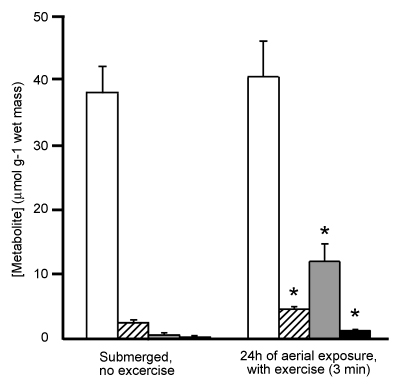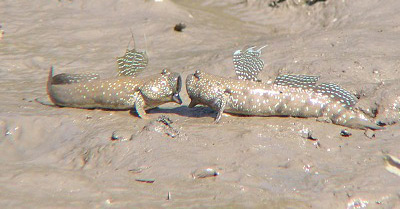|
As in the majority of fish species, and regardless of the degree of terrestriality
(e.g. in Periophthalmus, Periophthalmodon and Boleophthalmus
spp.) excretion in mudskippers is essentially realised through the gills, in the form of ammonia
and, to a less extent, urea.
In fact, a tendency towards ureotely (a relatively expensive metabolic process, widespread among living sarcopterygians - see also Fish Coming Ashore),
has never been demonstrated in any oxudercine gobies (Gregory, 1977; Evans
et al., 1999).
In general, mudskippers are highly resistant to ammonia loadings.
Peng et al. (1998) measured a tolerance of ammonia concentrations of about 450 μM NH3 for at least 7 days in Periophthalmodon schlosseri.
Such values are comparable only to Oreochromis alcalicus
grahami (= Alcalotilapia grahami, a cichlid which lives in African alkaline lakes, in waters with pH>9.5), but at much lower pH values.
The same authors measured that Boleophthalmus boddaerti (= B. boddarti) tolerated about 40 μM NH3; concentrations comparable to those tolerated by Periophthalmus cantonensis (= P. modestus:
Iwata, 1988), and to concentrations that were lethal for a sample of other freshwater, estuarine and tide pool gobioid fishes (about 45 μM NH3 for 24 hr: Iwata, 1988).
Both Pn. schlosseri and B. boddarti can decrease the rate of proteolysis and of amino
acid catabolism, thus slowing down the accumulation of ammonia (Lim et al., 2001).
Emergence and exposure of the gills to air drastically limits excretory functions, and mudskippers adopt different metabolic strategies to defend against ammonia
toxicity upon emergence.
When out of water, Pn. schlosseri detoxifies ammonia by accumulating alanine and producing energy through partial amino acid catabolism
(amination and transamination pathways). The efficiency of this process increases with the duration of emergence (Ip et al., 2001, 2004a). This physiological adaptation makes this species capable of intense and prolonged terrestrial activity, whilst not consuming its glycogen reserves,
the main energy source under water.
This strategy is probably adopted also by Periophthalmus modestus (Iwata
et al., 1981; Iwata, 1988).
|
|

Effects of three minutes of exercise
after 24 hours of aerial exposure in the muscle of Periophthalmodon schlosseri;
open bars= glycogen concentration; hatched bars= lactate; shaded bars= alanine; black bars= ammonia;
* significantly different from submerged conditions, in the absence of exercise (P<0.05).
From Ip et al., 2001, with the permission of the Company of Biologists Ltd.
|






